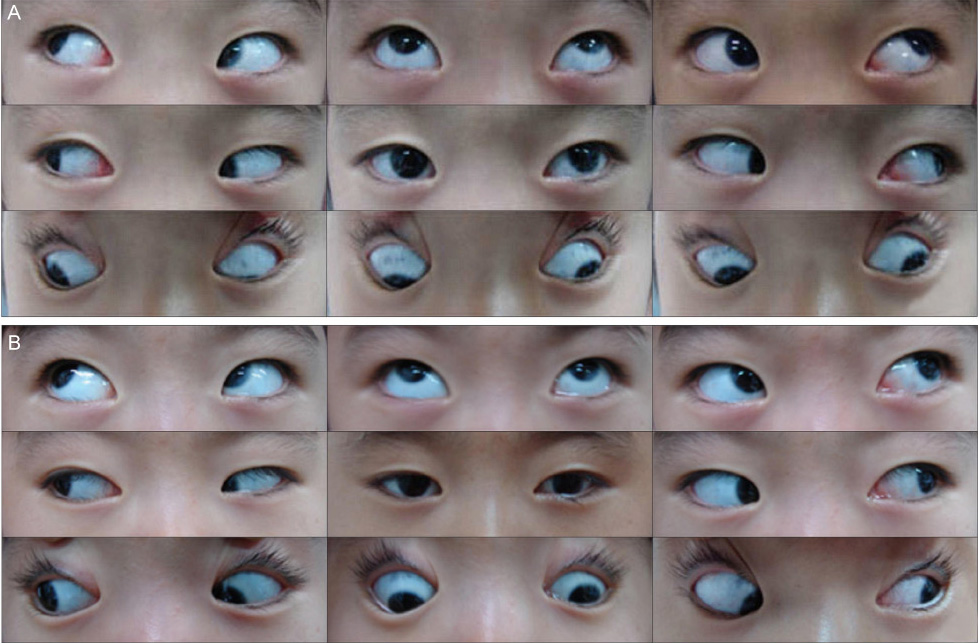Korean J Ophthalmol.
2009 Mar;23(1):62-64. 10.3341/kjo.2009.23.1.62.
Anomalous Scleral Insertion of Superior Oblique in Axenfeld-Rieger Syndrome
- Affiliations
-
- 1Department of ophthalmology, Chonnam National University Medical School & Hospital, Gwangju, Korea. exo70@naver.com
- KMID: 1115657
- DOI: http://doi.org/10.3341/kjo.2009.23.1.62
Abstract
- Axenfeld-Rieger syndrome (ARS) is associated with ocular and systemic anomalies. PITX2 is known to be a major controlling gene in the pathogenesis of ARS and is associated with differentiation in both the neural crest and mesoderm during eye development. A 4-year-old girl with bilateral ARS had 20 prism diopters (PD) of exotropia with 30PD of A- pattern deviation, more than 20PD of dissociated vertical deviation (DVD), and severe superior oblique overaction (SOOA). During surgery we observed that the SO inserted more posteriorly than normal. We believe this finding is one of the abnormal manifestations of the development of the extraocular muscles in ARS.
Keyword
MeSH Terms
-
*Abnormalities, Multiple
Anterior Eye Segment/*abnormalities
Child, Preschool
Eye Abnormalities/*diagnosis/surgery
Eye Movements
Female
Follow-Up Studies
Humans
Oculomotor Muscles/*abnormalities/surgery
Ophthalmologic Surgical Procedures/*adverse effects
Optic Nerve/abnormalities
Postoperative Complications
Sclera/*pathology/surgery
Syndrome
Tooth Abnormalities/*genetics
Figure
Cited by 1 articles
-
Novel c.300_301delinsT Mutation in
PITX2 in a Korean Family with Axenfeld-Rieger Syndrome
Jae Won Yun, Hyun-Kyung Cho, Soo-Young Oh, Chang-Seok Ki, Changwon Kee
Ann Lab Med. 2013;33(5):360-363. doi: 10.3343/alm.2013.33.5.360.
Reference
-
1. Amendt BA, Semina EV, Alward WL. Rieger syndrome: a clinical, molecular, and biological analysis. Cell Mol Life Sci. 2000. 57:1652–1666.2. Ozeki H, Shirai S, Ikeda K, Ogura Y. Anomalies associated with Axenfeld-Rieger syndrome. Graefes Arch Clin Exp Ophthalmol. 1999. 237:730–734.3. Alward WL. Axenfeld-Rieger syndrome in the age of molecular genetics. Am J Ophthalmol. 2000. 130:107–115.4. Diehl AG, Zareparsi S, Qian M, et al. Extraocular muscle morphogenesis and gene expression are regulated by Pitx2 gene dose. Invest Ophthalmol Vis Sci. 2006. 47:1785–1793.5. Traboulsi EI. Ocular malformations and developmental genes. J AAPOS. 1998. 2:317–323.6. Kitamura K, Miura H, Miyagawa-Tomita S, et al. Mouse Pitx2 deficiency leads to anomalies of the ventral body wall, heart, extra- and periocular mesoderm and right pulmonary isomerism. Development. 1999. 126:5749–5758.7. Prieto-Diaz J, Souza-Dias C. Strabismus. 2000. 4th ed. Boston Oxford Auckland Johannesburg Melbourne New Delhi: Butterworth-Heinemann;247–288.
- Full Text Links
- Actions
-
Cited
- CITED
-
- Close
- Share
- Similar articles
-
- A Case of Axenfeld-Rieger Syndrome with Severe Mitral Regurgitation
- Department of Ophthalmology, Taegu Fatima Hospital
- A Family with Axenfeld-Rieger Syndrome: Report of the Clinical and Genetic Findings
- Novel c.300_301delinsT Mutation in PITX2 in a Korean Family with Axenfeld-Rieger Syndrome
- Trypan Blue-Assisted Measurements of Anatomical Positions of the Superior Rectus Muscle and Superior Oblique Muscle in Enucleated Eyes



